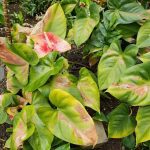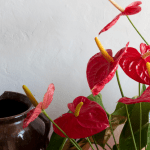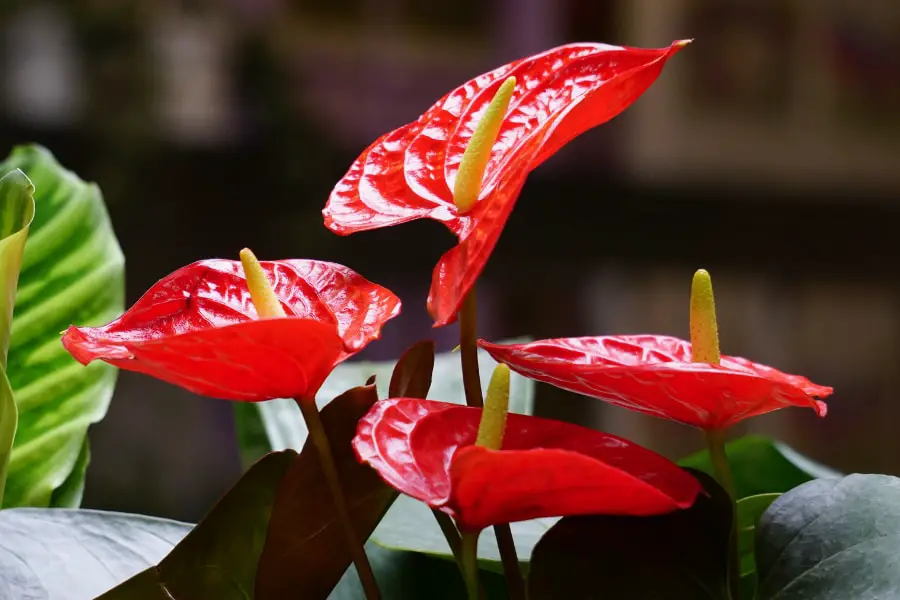
Flamingo flower (Anthurium andraeanum), sometimes called a flamingo lily or flamingo plant, is a flowering houseplant that I would consider challenging to grow. In this post, I’ll show you how to care for flamingo flower to make things a bit easier!
This tropical houseplant boasts dramatic, arrow-shaped leaves and waxy flowers that come in a variety of colors, depending on the variety. Red is the most common, but purple, burgundy, pink, and white are also popular.
Anthurium flowers bloom throughout the year when the plant is grown indoors, and the blooms last for many weeks. They’re made up of a tear-shaped spathe and a long spike of tiny flowers known as the spadix.
How to Care for Flamingo Flower
Anthurium is not the easiest houseplant to grow indoors. It can be fussy, but if you maintain ideal conditions – including high humidity – you can see it thrive in your home. Here are the basics of caring for flamingo flower:
- TEMPERATURE: 61 – 75 degrees F (16 – 24 degrees C)
- LIGHT: Bright, indirect light
- HUMIDITY: High humidity
- WATER: Keep soil moist at all times
- FEEDING: Feed every two weeks during spring and summer
- SAFETY: Toxic to dogs and cats
- DIFFICULTY: Challenging
Read on for more in-depth care guidelines including potting, propagation, maintenance, and troubleshooting.
Water Requirements
Water flamingo flower enough to keep soil moist all year, and avoid over-watering. Anthurium doesn’t like soil that’s too wet or too dry. Too much water and plants may develop root rot, but you do need to keep the soil moist – especially during summer.
I’ve found that giving it a little water every other day seems to keep the plant happy during spring and summer – just allowing the surface of the soil to become dry. In fall and winter, reduce watering until the top half inch of soil dries out before watering again.
Humidity Needs
To keep the humidity high enough and promote adequate draining, place flamingo flowers on a humidity tray. See my post on how to make a humidity tray if you’re not familiar with this process. It’s a must for this plant.
Mist the foliage regularly (avoiding flowers) with lukewarm water or place the plant near a good quality humidifier. Or better yet – do both. Anthurium requires high humidity to survive indoors. This is what makes it so challenging to grow.
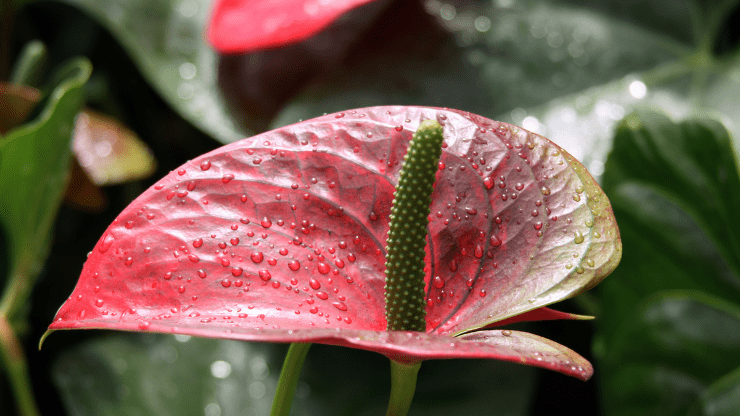
Click here to see our favorite houseplant humidifier on Amazon or read my review here to see why I love this one so much. (It’s the one I’m currently using for my anthurium plants.)
Feeding Your Plant
Feed your anthurium plants with a water-soluble fertilizer formulated for flowering houseplants (we like Jack’s Houseplant Special) diluted to 1/4-strength every two weeks in spring and summer. For example, if the label on your fertilizer says to use 1 teaspoon, you should use 1/4 teaspoon.
Flamingo flower cannot handle large doses of fertilizer and will easily burn if you don’t dilute it. Also, you should never apply fertilizer if the plant is stressed, has brown leaves, or if the potting soil is completely dry.
Allow the plant to rest in fall and winter, giving it a break from feeding.
Light for Flowers
Grow flamingo flowers in bright, indirect light to ensure flower production. The medium light of an east- or west-facing window is ideal. A north-facing window may not provide adequate light and a south-facing window may be too harsh.
Always avoid direct sunlight. If you place your plant in a south-facing window, make sure it’s protected from the glare of direct sun by keeping it about three feet away from the glass.
If you don’t have an area in your home bright enough, you may need to supplement with artificial light to get blooms. The plant won’t flower – at least not much – if you don’t have adequate light. Click here to read about our favorite lights for indoor plants.
Optimal Temperature
Flamingo flower is highly sensitive to low temperatures. (Remember, it’s a tropical plant native to warm, moist rain forests.) Never allow the temperature to fall below 61 degrees F (16 degrees C) in your house or the plant may not survive.
For the best results, keep the plant in a warm area year round – preferably around 70 degrees F (21 degrees C), but never above 80 degrees F (26 degrees C).

Potting & Soil
Plant the top of the root ball 1 inch (2.5 cm) below the soil surface in a 5-8 inch (12.5-20 cm) pot. Use a light, porous, and well-draining potting soil. Repot anthurium plants only when the plant becomes root-bound in a pot one size bigger than its current container.
There are a lot of differing opinions in the gardening world about which soil mixture works best. In my experience, anthuriums do best in a combination of moisture control potting mix, peat moss, orchid potting mix, and perlite.
Here’s the recipe I’ve been using with success for the past 10 years:
- 50% Miracle Grow Moisture Control Potting Mix
- 20% Peat Moss
- 20% Orchid Potting Mix
- 10% Perlite
Some of these items might be hard to find locally, so the links above will take you to Amazon where you can purchase them online.
My anthuriums thrive in this mixture. It’s coarse, well-draining, and allows the soil to stay damp but not soggy. It’s very similar to the soil in a rain forest, which is why it works so well for tropical plants like this one.
Flower Propagation
Anthuriums can be propagated by taking cuttings or dividing roots and stems. I prefer to propagate my anthurium plants by dividing the roots when repotting – once every two years or so (as they outgrow their current container).
I have never personally propagated this plant by taking cuttings. If you do, make sure to take them from 3 to 4-year old plants. Each cutting should have a few roots attached or at least a single bud to produce new roots.

Plant Maintenance
Regularly wipe the mature leaves of your flamingo flower plant with a soft sponge or damp, soft cloth. Avoid handling any new, soft leaves until they’ve become dark and glossy. (See my post on cleaning your plant’s leaves for more information.)
The flowers of the spadix can cause a mess with their pollen. If it bothers you, snip off the spadix and this will extend the life of the glossy spathe a bit longer. Gently pull off spent flowers as needed.
Troubleshooting Flamingo Flower Plants
Here are some common issues indoor gardeners often have with flamingo flower plant (and solutions for fixing them).
Flowers Wilting
Usually the result of cold temperatures or not enough light. Make sure your plant is warm and has plenty of filtered sunlight. If you’re struggling, invest in supplemental lighting and/or heating to keep your plant happy.
Brown Patches
On leaves or flowers, brown patches typically indicate the presence of fungus. Cut off any infected growth with sterile shears and spray with a fungicide. It may not be possible to save plants infected with fungus, but if you catch it early there is a chance.
Leaves Turning Yellow
If your leaves are turning yellow or wilting, the plant is either too wet or too cold. You may be over-watering or allowing temperatures to drop too low. Let it dry out and move it to a warmer location.
Brown Leaf Tips
If the tips of your plant’s leaves are turning brown, it’s most likely because it’s getting too much sun or the air isn’t humid enough. Make sure it’s never exposed to direct sunlight and move it further from the window. Increase humidity by misting or placing near a humidifier.
See my post about brown spots on anthurium leaves for more solutions.
No Blooms
If your flamingo flower isn’t flowering, it’s most likely underfed or not getting enough light. Move to a brighter location and feed once every two weeks with a diluted bloom-promoting fertilizer.
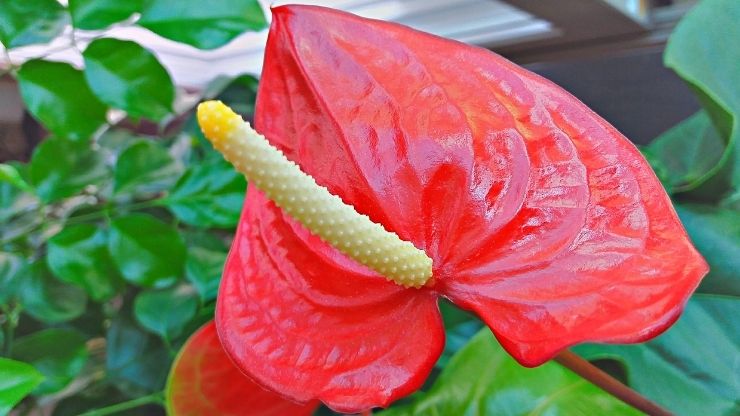
Anthurium Care Related Questions
I’m answering your questions about how to care for anthurium! These are commonly searched for questions on this site or they’ve been sent to me via email.
How Much Light Does a Flamingo Flower Need?
As discussed above, anthurium needs bright, indirect light for most of the day (6 – 8 hours at least in spring and summer). If you can’t place in an east-facing window, supplement with artificial lighting.
Is Flamingo Flower Indoor or Outdoor?
Flamingo flowers can be grown as both indoor plants and outdoor plants. It’s care will be a bit different outdoors, however, and it’s only hardy in growing zones 10 – 12 where it rarely gets cold enough to cause damage.
Is Anthurium Really Named After a Flamingo?
Sort of. The plant gets its common name from the bold, showy appearance of its flowers, which it has in common with the flamingo.
How Do You Prune Flamingo Flowers?
It’s easy to prune a flamingo plant. Snip off spent flowers with a clean and sterilized pair of pruning shears. Make sure to snip them off at the base of the stem (and the same goes for dead foliage). You don’t need to prune the plant back unless you’re removing dead flowers or leaves.
Why Is My Flamingo Flower Dying?
The most common reasons include low humidity, too much sunlight (or too little), and too much water. Low moisture is the number one reason a flamingo flower fails to thrive.
Increase humidity around your anthurium plants by misting or placing near a humidifier, make sure you’re giving it enough bright indirect sun (but no direct sunlight), and water just enough to keep soil moist but not wet (avoid root rot from overwatering).
See my post on how to bring anthurium back to life if you have a dying plant you want to save.
Where to Buy Plants
Anthurium might be hard to find in local nurseries and garden centers. I have not had much luck finding it in my area, but I live in an arid climate. It might be easier to find in more tropical locations – such as gardening hardiness zones 10 – 12 where it’s grown outdoors.
When I can’t find plants locally, I prefer to order them on Esty. Buying your houseplants on Etsy supports small growers, who (in my opinion) care more about the quality of their plants and have better customer service than large corporate nurseries.

I’ve ordered numerous plants from sellers on the site and they have always been fantastic quality. Plus, you can find many plant varieties that you would never be able to get locally. And you can get some very good prices for plants in various stages of growth.
I know it sounds weird to order plants online, but give it a try and you’ll be hooked! Click here to see the current listings for flamingo flower on Etsy.
Tip: When searching for plants on Etsy, look up all the plant’s common names. In this case, try searching for “flamingo lily” or “flamingo plant” to see if you get additional listings.
Anthurium Cultivars
You can also find various anthurium cultivars on Etsy (or where ever you purchase your plants). These are great if you want a flamingo flower, but you want something a bit different from the standard waxy red flower. Some of my favorites include:
- Anthurium Andraeanum “Zizou” – This flamingo flower plant produces beautiful but small lavender purple flowers, and it’s compact in size reaching only about 4 inches (10 cm) in height.
- Anthurium Andraeanum “Black Beauty” – This is my favorite flamingo flower cultivar. Black beauty produces incredible deep purple flowers that almost appear black in color.
- Anthurium Andraeanum “Simba” – If you want something a bit lighter, “Simba” produces white to yellow-white flowers with a greenish tint on the bottom edge of the bloom.
There are dozens more anthurium cultivars out there that produce many different colored flowers – from the traditional waxy red flower to deep purple, white, yellow, and light pink. Shop around and find the perfect flamingo flower for you!

